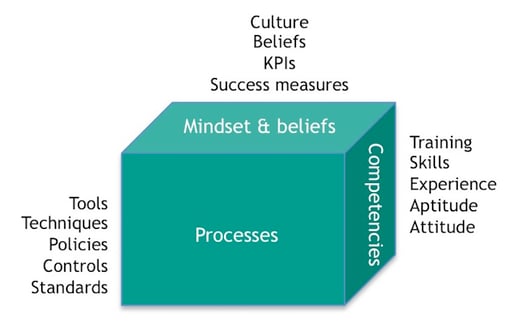This is a synopsis of presentation by Jed Simms, Founder and principal creator of TOP® at the ProjectChat conference 2015
Organizations go to great pains to implement ‘benefits management’ but, when you go back two years later, most of these initiatives have failed and disappeared. Why? Simply, the prerequisites to adopting benefits management in an organization have not been addressed.
There are three key dimensions that need to be addressed that are illustrated by the TOP Value Cube™
The TOP Value Cube™

You need to address these three dimensions in the right order.
1 BELIEFS
There are several false beliefs and limiting mindsets that prevent benefits management being adopted.
For example, many a CEO believes that “You can build it (the project) and they (the benefits) will come.” This is fallacious. Only around 20%-30% of benefits will automatically be realized on delivery of the project; the other 70% plus of benefits need to be identified, planned for, targeted, delivered and measured. But, as long as this 'automatic delivery' belief is held at senior levels, a focus on benefits management will be considered unnecessary.
Step 1 — Address all of the false beliefs and limiting mindsets.
(To help, TOP has published “The 19 Myths that are destroying your project investments”)
2 PROCESSES
Most of the processes required to successfully (and easily) deliver benefits are missing or deficient. This is because they are not needed for orthodox project management that focuses on costs rather than value.
For example, few organizations define in clear, specific, measurable terms their target desired business outcomes, benefits and value and then plan their projects specifically to deliver this value. This leads to projects and benefits becoming separated (if they were ever connected). The project delivers its ‘outputs’ and the business then has to work out how to deliver the benefits. This approach makes benefits management hard work and extra cost which is unnecessary.
A simple Value Equation™ process that is used to drive the project makes the project itself the principal benefits delivery process.
Step 2 — Put in place all of the benefits identification, planning, protection and delivery processes.
(To help, TOP has published “Managing for Value” that describes all of the processes required.)
3 COMPETENCIES
When you have supportive mindsets and effective benefits delivery processes you can invest in developing the skills and competencies required to identify, plan, protect and deliver the benefits. These skills need to be at the executive level, on governance teams and in the business as well as on the projects as systems implementers, vendors and contractors rarely have a vested interest in being ‘value delivery focused’. They get their money even if the project fails.
Step 3 — Certify your business staff's benefits skills and competencies.
(To help, TOP provides a complete set of benefits management tools, techniques, processes and training for business management and staff to know what to do, when, why and how.)
When you don’t address these three dimensions in this order, at best you can only hope for some additional benefits on some projects. However, when you address all three dimensions effectively you’ll find benefits management can be simple, sustainable and very valuable.



